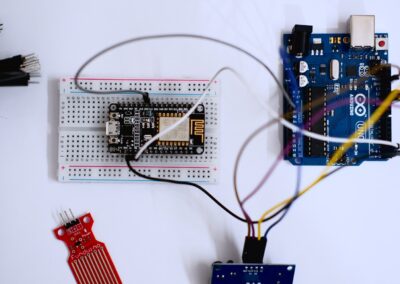The Importance of Code Signing in IoT Security
How Code Signing Ensures Authentic IoT Firmware Updates
Code signing in IoT firmware updates is a critical security measure that ensures the authenticity and integrity of the code being installed on IoT devices. In rapidly advancing regions like Saudi Arabia and the UAE, where cities such as Riyadh and Dubai are at the forefront of technological adoption, maintaining the security of IoT firmware updates is paramount. Code signing involves the use of digital signatures to verify that the firmware being installed comes from a trusted source and has not been tampered with.
The process of code signing involves generating a digital signature using a private key, which is then attached to the firmware update. When the IoT device receives the update, it uses a corresponding public key to verify the signature. If the signature is valid, the device proceeds with the installation, ensuring that the firmware is authentic and has not been altered. This mechanism prevents malicious actors from injecting harmful code into IoT devices, which could compromise their functionality and security. In Riyadh, where smart city initiatives depend on the reliability of IoT systems, code signing plays a vital role in safeguarding these networks.
Moreover, code signing builds trust between IoT manufacturers and users. By providing a verifiable way to ensure the authenticity of firmware updates, manufacturers can reassure users that their devices are secure and that updates are legitimate. In Dubai, where IoT devices are extensively used in public services and infrastructure, maintaining this trust is crucial for the continued success and expansion of smart technologies.
Best Practices for Implementing Code Signing in IoT
Implementing code signing in IoT firmware updates requires adherence to best practices to ensure its effectiveness. One essential practice is the use of robust encryption algorithms for generating digital signatures. Organizations should use industry-standard algorithms, such as RSA or ECC, to create strong, secure signatures that are difficult for attackers to forge. In Saudi Arabia, businesses and government entities can collaborate with cybersecurity experts to select and implement the most appropriate encryption methods for their IoT systems.
Another crucial practice is the secure management of code signing keys. The private key used to generate digital signatures must be protected against unauthorized access and theft. Organizations should store private keys in secure hardware modules, such as Hardware Security Modules (HSMs), which provide physical and logical protection against attacks. Regular audits and monitoring of key usage can also help detect and prevent any unauthorized attempts to access or use the keys. In Dubai, implementing stringent key management practices is essential for ensuring the integrity of IoT firmware updates across various sectors.
Additionally, organizations should establish clear policies and procedures for the code signing process. This includes defining roles and responsibilities for key management, specifying the steps for generating and verifying digital signatures, and outlining the procedures for handling key compromises. By developing comprehensive policies, organizations can ensure that the code signing process is consistently followed and that all firmware updates are authenticated. In Riyadh, where smart city projects involve numerous stakeholders, clear policies and procedures are vital for maintaining the security of IoT systems.
Case Studies: Successful Code Signing Implementations
Several organizations in Saudi Arabia and the UAE have successfully implemented code signing to enhance the security of their IoT firmware updates. For example, a telecommunications company in Riyadh integrated code signing into its IoT-enabled communication infrastructure. By using robust encryption algorithms and secure key management practices, the company ensured that all firmware updates were authenticated and protected against tampering. This initiative significantly enhanced the security of its communication network, providing reliable and secure services to its customers.
In Dubai, a smart transportation project adopted code signing to secure firmware updates for its fleet of IoT-enabled vehicles. The project implemented a comprehensive code signing policy, including the use of HSMs for key storage and regular audits of key usage. By ensuring the authenticity of firmware updates, the project maintained the security and reliability of its transportation network, reducing the risk of cyberattacks and enhancing public trust in smart transportation solutions.
Another notable example is a healthcare provider in the UAE that used code signing to secure firmware updates for its IoT-enabled medical devices. By implementing industry-standard encryption algorithms and secure key management practices, the provider ensured that all firmware updates were authenticated and protected against tampering. This initiative enhanced the security of its medical devices, protecting patient data and improving the overall reliability of its healthcare services.
Best Practices for Managing Code Signing Keys
Ensuring Secure Storage and Access Control
Effective management of code signing keys is crucial for maintaining the integrity and security of IoT firmware updates. One of the best practices is ensuring secure storage and access control for private keys. Organizations should use Hardware Security Modules (HSMs) to store private keys, as these devices provide robust protection against physical and logical attacks. HSMs also support secure key generation and storage, ensuring that keys are never exposed outside the secure environment.
Access control is another critical aspect of key management. Organizations should implement strict access control policies to ensure that only authorized personnel can access and use the private keys. This includes defining roles and responsibilities, implementing multi-factor authentication (MFA) for key access, and regularly reviewing access permissions. In Saudi Arabia, where IoT devices are widely used in critical infrastructure, secure storage and access control are essential for maintaining the integrity of firmware updates.
Regular audits and monitoring of key usage can help detect and prevent unauthorized access to private keys. Organizations should implement logging and monitoring solutions to track key usage and detect any anomalies. Regular audits can also help identify potential security gaps and ensure that key management practices comply with industry standards and regulations. In Dubai, continuous monitoring and auditing of key usage are vital for maintaining the security of IoT firmware updates in various sectors.
Establishing Comprehensive Key Management Policies
Developing and implementing comprehensive key management policies is essential for the effective management of code signing keys. These policies should outline the entire lifecycle of key management, including key generation, storage, usage, and destruction. By defining clear procedures and guidelines, organizations can ensure that all aspects of key management are consistently followed and that private keys are protected against unauthorized access.
Key generation is a critical step in the key management lifecycle. Organizations should use secure methods for generating private keys, such as using HSMs or trusted key generation services. The generated keys should be immediately stored in secure environments to prevent exposure. Additionally, organizations should implement key rotation policies to ensure that keys are regularly updated and replaced, reducing the risk of key compromise.
Key destruction is another important aspect of key management. When private keys are no longer needed or have been compromised, they should be securely destroyed to prevent misuse. Organizations should define clear procedures for key destruction, including the use of secure methods such as physical destruction of HSMs or secure deletion of key files. In Riyadh, developing comprehensive key management policies is essential for ensuring the security of IoT firmware updates across various industries.
Conclusion: Future-Proofing IoT Security with Code Signing
As IoT technology continues to evolve, ensuring the authenticity and integrity of firmware updates through code signing will remain a top priority for organizations. By implementing robust code signing practices and secure key management policies, businesses in Saudi Arabia and the UAE can protect their IoT devices from cyber threats and maintain the trust of their users. Leveraging advanced encryption algorithms, secure storage solutions, and comprehensive policies, organizations can future-proof their IoT security and ensure the reliability of their systems.
In conclusion, code signing is a critical security measure for IoT firmware updates, providing a robust defense against unauthorized modifications and cyber threats. By adopting best practices for code signing and key management, organizations can safeguard their IoT networks and maintain the integrity of their firmware updates. As the technological landscape continues to evolve, businesses that prioritize IoT security will be well-positioned to achieve long-term success and maintain a competitive edge in the digital age.
—
#CodeSigning #IoTSecurity #FirmwareUpdates #AuthenticIoTUpdates #ManagingCodeSigningKeys #BusinessSuccess #ModernTechnology #LeadershipSkills #ProjectManagement #SaudiArabia #UAE #Riyadh #Dubai #ArtificialIntelligence #Blockchain #TheMetaverse #ExecutiveCoachingServices #GenerativeAI































